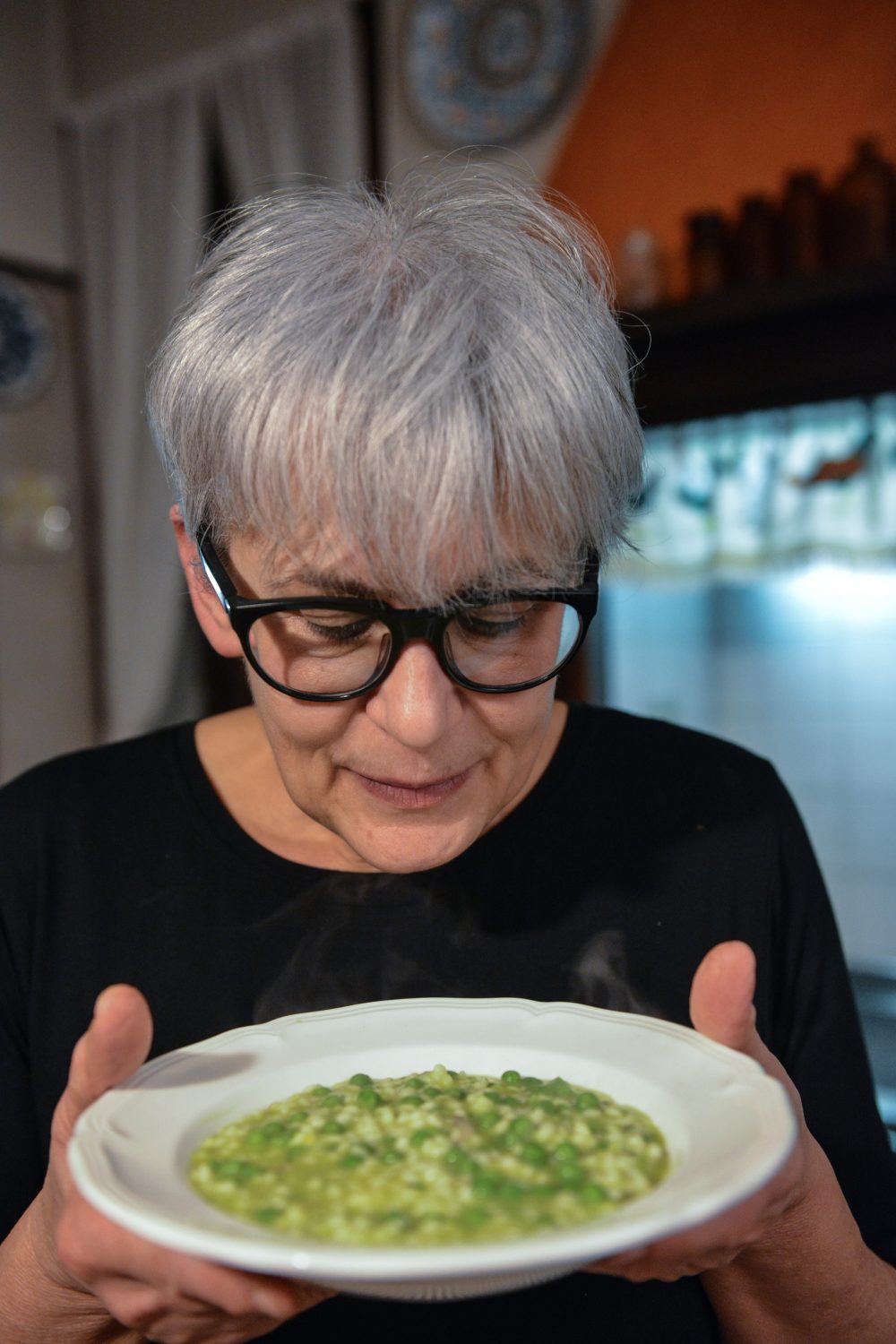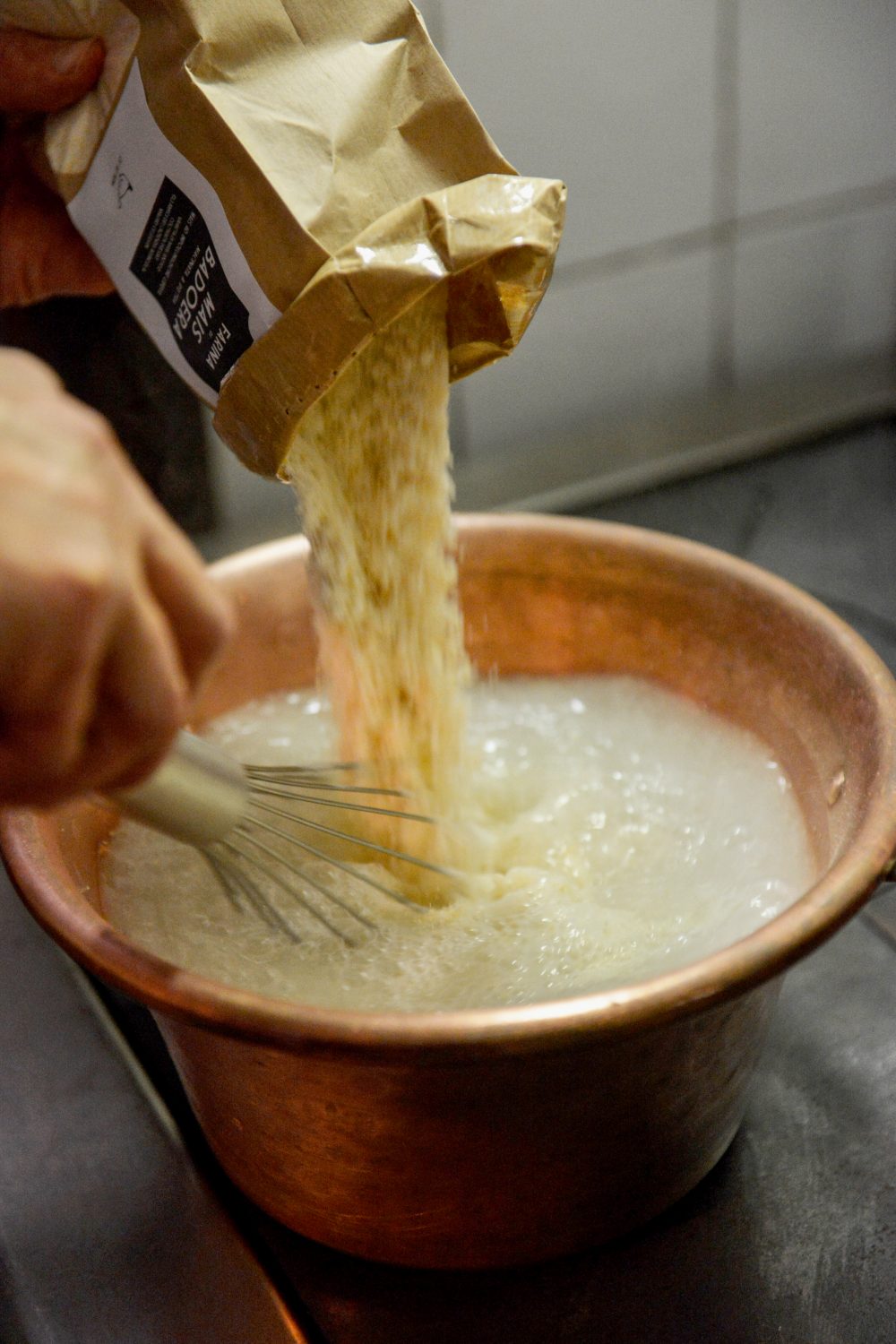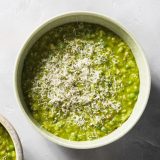Michela Tasca’s calm poise belies an apparent love of the unexpected. Her vegetable stock, for example. An all-in affair that verges more on bisque than broth. Her polenta? No cheese, please. But do mound on the shrimp, and don’t be shy with the garlic. Her career, too, from fashion designer to farmer. Even the farm itself is a model in the art of transformational pivots.
She stands in her mother-in-law’s kitchen, one of several at the farm in Piombino Dese, a village 45 minutes northwest of Venice, and casually assembles samples of the region’s rustic, yet vibrant cooking. Pumpkin punctuated with onions, pine nuts and plump raisins. Bigoli pasta tossed with briny, tender sardines and jammy onions. A simple, strikingly green rice and peas. Creamy polenta and shrimp.
And through each bite, her story—one of a farm and its family—unfolds. She met her husband, Ottorino Scquizzato, here in 1978. His sister was Tasca’s friend and she wanted the two to meet. He didn’t. “No, your friends are awful,” he said. Or maybe not all of them. Their first date they ate rabbit stew and danced to Lucio Battisti in a room just off this same kitchen.
The farm has been in Scquizzato’s family for nearly 100 years, a rambling assemblage of barns and bedrooms, stone paths that crunch under-foot, mounds of pumpkins and winter squash that loiter in corners, and fowl. So many varieties of fowl. Except, it wasn’t always a farm. And Scquizzato and the generations before him weren’t always farmers.

At her farm outside Venice, Michela Tasca offers lessons in the region’s rustic cooking.
Brooms, he says matter-of-factly while sitting—bundled against the chilly, rainy day—in what the family calls the Summer Room, a large hall with walls of black-and-white photos of relatives past. Until World War II, the tidy 4-hectare farm was home to the family’s broom-making business. Old-school straw brooms.
Then came the war. And with it, plastic. Natural brooms fell from favor, so his family did the first of several pivots. With 100 cows—a considerable number for the period—broom making gave way to dairy farming. But in time, the growth of industrial-scale agriculture forced yet another reckoning.
Tasca, meanwhile, worked with her father and siblings in fashion. But as the farm struggled, she decided it was time for a new challenge. The cows were replaced by heritage poultry and heirloom produce. Spare bedrooms were opened to paying guests, a nod to the many strangers who invited themselves over the years after mistaking the family’s rollicking and sprawling dinners for a restaurant. And Tasca returned to school, earning a graduate degree in food culture.
As she stands in the kitchen this day, calmly stirring rice and peas—risi e bisi—you’d think it all was planned. Of course, that’s the lesson. Tasca and Scquizzato reflect perfectly the food around them. Cucina povera, as the cooking of Veneto is, too often is translated too literally: poor kitchen. But that’s not a reflection of the food or the people who prepare it.
“Risi e bisi is neither a risotto nor a soup. It is half and half,” explains Michela Tasca. “It has too much broth to be a risotto. But it’s too thick to be a soup.” And in her hands, the middle ground between them is deliciously fresh and savory, with pops of sweet peas.
There is nothing poor about this food. Rather, cucina povera is about making delicious whatever you happen to have around you. Just as Tasca and Scquizzato built a delicious life out of brooms. And cows. And produce. And fashion. And poultry.
And today, they build it for me from peas and rice. And shrimp and polenta. First is the risi e bisi, tender, plump grains of starchy white rice cooked with peas. Though the recipe is deceptively simple, the rice creates richness. “Risi e bisi is neither a risotto nor a much broth to be a risotto. But it’s too thick to be a soup.” Except Tasca’s take is different from any I’ve seen. Of course.
She begins by making a vegetable broth, but not like any I’ve had. Carrot, onion, celery and parsley simmer in water. This I expect. Some peas go in, too. But when most cooks would strain out and discard the vegetables, assuming they have nothing left to offer, Tasca grabs an immersion blender and purees the mixture until smooth and minty green.
The rest is conventional. The results are anything but. Rice is cooked with rich pancetta and sweet onion, with the rich broth slowly ladled in, plumping the rice. More peas—and I love that even here in Italy, when peas are out of season, frozen are a fine substitute for fresh—are stirred in at the end, the late addition helping to preserve their color and flavor. Grated Parmesan cheese adds savory depth. The finished dish is equally fresh and rich, so much more than simple rice and peas. The secret, of course, is the broth, adding flavor and body.

Creamy polenta creates the perfect foil for briny shrimp in a spicy-sweet tomato sauce.
From there, we move to the pumpkin, sweet and savory and crunchy and tender. And the pasta, drenched in sardines that melted in the pan and onions that browned until sweet. But the next star to emerge was even simpler than the peas and rice: polenta e schie, a classic from Venice that combines silky polenta with the tiny local shrimp known as schie.
We think of shrimp as an extravagance. But for generations in Venice they were the food of the poor. An abundantly available, versatile and affordable ingredient. And people clearly learned to very much make the most of what they had on hand. The polenta itself is simple and clean and creamy. Ground corn and water that simmers slowly, becoming smooth and rich. No cheese to weigh it down or cloud its flavor. Just simple, pure corn.
To top it, the shrimp can be prepared two ways. They can be dusted with flour, then fried crisp, shells and heads and all, and simply spooned onto tender polenta. Or tomatoes can be cooked down with olive oil and ample garlic. Shrimp then are stirred in at the end, cooking for just minutes in the residual heat of the sauce to ensure they stay plump and tender. The result is rich, sweet and tomatoey, the tender shrimp acting as a lovely briny counterpoint to the creamy polenta.
We favored the tomato version, loving the gentle and sweet acidity against the polenta. But more than anything, we loved Tasca’s approach to food. Simple, beautiful, delicious and adaptive. Like her farm. Like her life.





